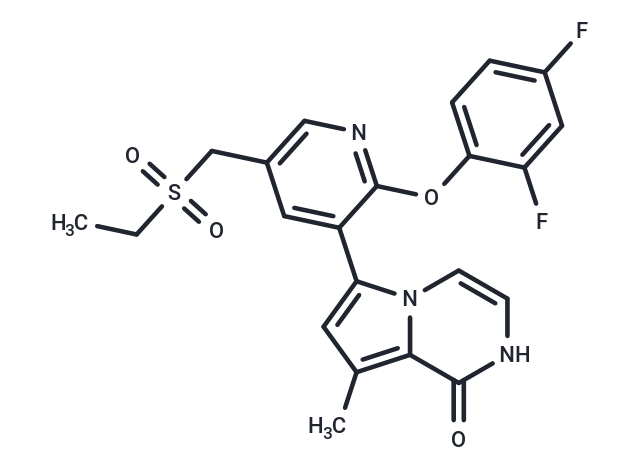Shopping Cart
- Remove All
 Your shopping cart is currently empty
Your shopping cart is currently empty

BET bromodomain inhibitor 1 is an orally active, selective inhibitor of bromodomain and extra-terminal (BET) proteins, specifically inhibiting BRD4 with an IC50 of 2.6 nM. It also demonstrates high affinities towards BRD2(2), BRD3(2), BRD4(1), BRD4(2), and BRDT(2) with Kd values of 1.3 nM, 1.0 nM, 3.0 nM, 1.6 nM, and 2.1 nM, respectively. This compound exhibits anti-cancer activity.


| Description | BET bromodomain inhibitor 1 is an orally active, selective inhibitor of bromodomain and extra-terminal (BET) proteins, specifically inhibiting BRD4 with an IC50 of 2.6 nM. It also demonstrates high affinities towards BRD2(2), BRD3(2), BRD4(1), BRD4(2), and BRDT(2) with Kd values of 1.3 nM, 1.0 nM, 3.0 nM, 1.6 nM, and 2.1 nM, respectively. This compound exhibits anti-cancer activity. |
| Targets&IC50 | BRD4(1):3.0 nM (Kd), BRD4(2):1.6 nM (Kd), BRD3(2):1.0 nM (Kd), BRD2(2):1.3 nM (Kd), BRDT2:2.1 nM (Kd), BRD4:2.6 nM (IC50) |
| In vitro | BET bromodomain inhibitor 1 (compound 38; concentration range 31.25-125 nM; incubated for 24 hours) significantly induces G1-phase cell cycle arrest. At 31.25-500 nM for 6 or 24 hours, it triggers dose-dependent inhibition of c-Myc expression and increases p21 levels. In the same dose range over 6 hours, it markedly decreases c-Myc, BCL-2, and CDK6 expressions. This inhibitor does not affect five cytochrome P450 enzymes (IC 50 >20 μM) and is approximately 1500 times more selective for BRD4(1) compared to EP300 (IC 50 =3857 nM). It potently suppresses the growth of several cancer cell lines, including acute myeloid leukemia (MV4-11), acute leukemia (Kasumi-1 and RS-4-11), and multiple myeloma (MM1.S), with IC 50 values of 2.4, 4.8, 17.6, and 15.1 nM, respectively. Cell cycle analysis, Western blot, and RT-PCR in MV-4-11 cells corroborate these findings, highlighting its pronounced effect on G1-phase arrest, and the reduction of key oncogenic proteins and cell cycle regulators. |
| In vivo | BET bromodomain inhibitor 1, when administered orally at doses of 6.25 and 12.5 mg/kg daily for 28 days, demonstrated significantly enhanced antitumor efficacy, completely suppressing tumor growth with a tumor growth inhibition (TGI) rate of 99.7% at 12.5 mg/kg in an MV4-11 mouse xenograft model. Pharmacokinetic studies show that at a dose of 1 mg/kg intravenously in male SD rats, this inhibitor had a half-life (T 1/2) of 1.3 hours, a clearance rate (CL) of 21.5 mL/min/kg, and a steady-state volume of distribution (V ss) of 1464 mL/kg. Moreover, when given orally at 3 mg/kg in rats, the compound had a T 1/2 of 3.6 hours, reached a maximum concentration (C max) of 159 ng/mL, and had an area under the curve (AUC) of 884 ng·h/mL; while at a dose of 1.3 mg/kg orally in mice, it exhibited a T 1/2 of 1.3 hours, a C max of 399 ng/mL, and an AUC of 1710 ng·h/mL. |
| Molecular Weight | 459.47 |
| Formula | C22H19F2N3O4S |
| Cas No. | 2411226-02-1 |
| Relative Density. | 1.43 g/cm3 (Predicted) |
| Storage | Powder: -20°C for 3 years | In solvent: -80°C for 1 year | Shipping with blue ice. |

Copyright © 2015-2025 TargetMol Chemicals Inc. All Rights Reserved.